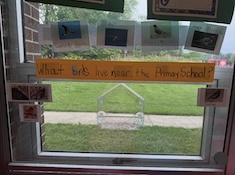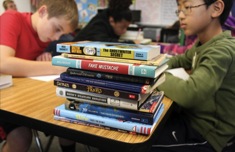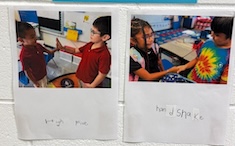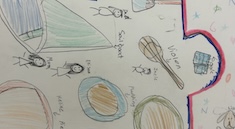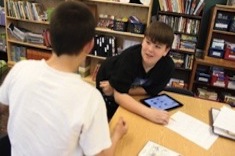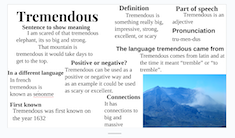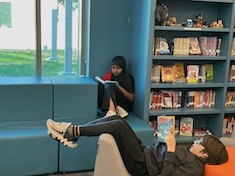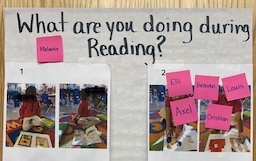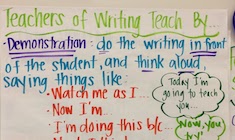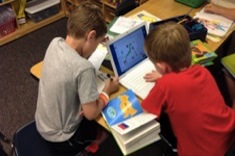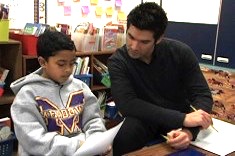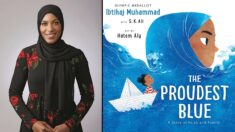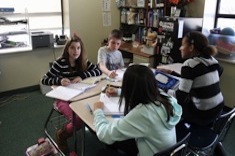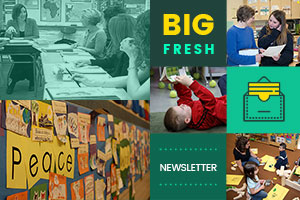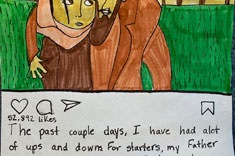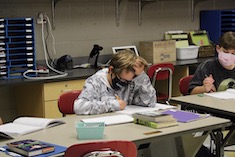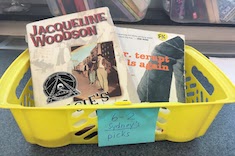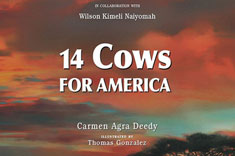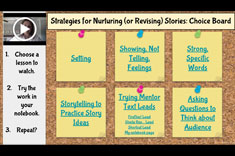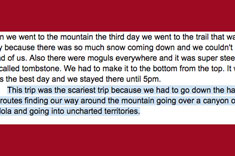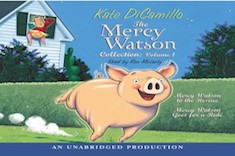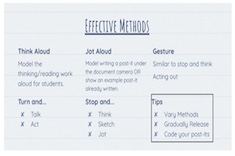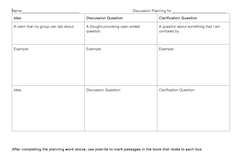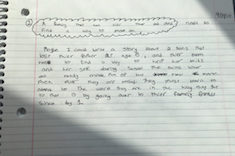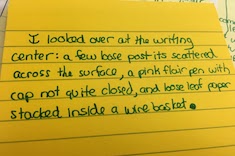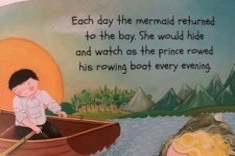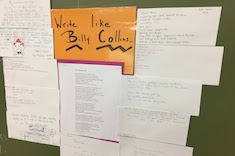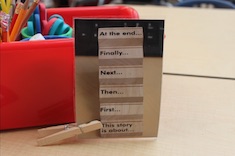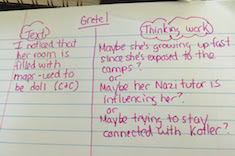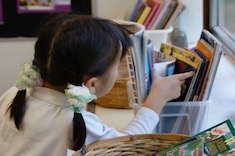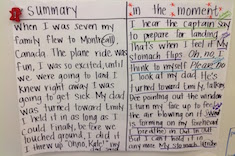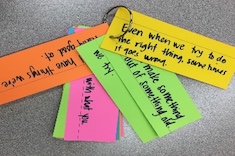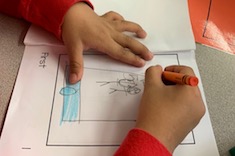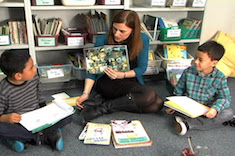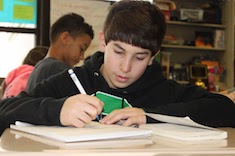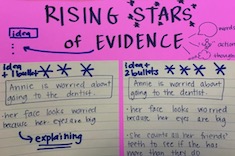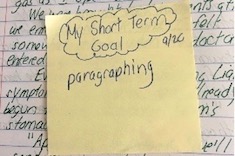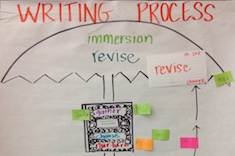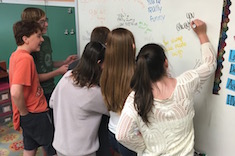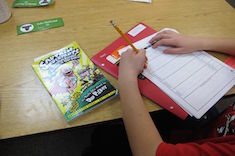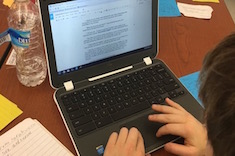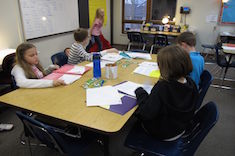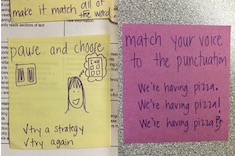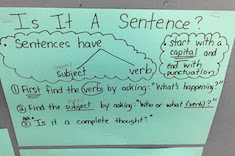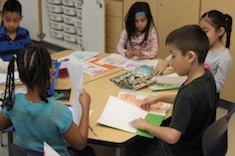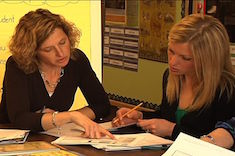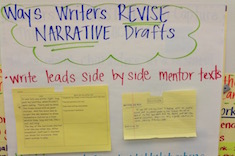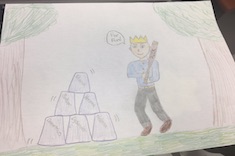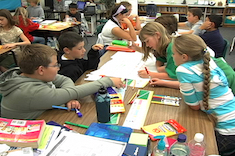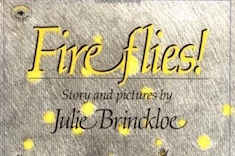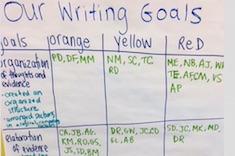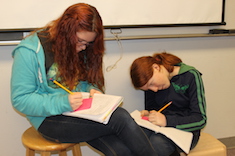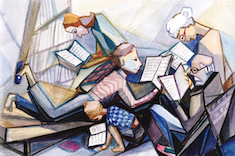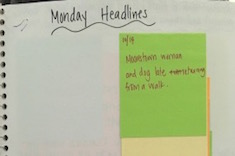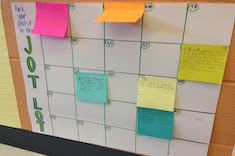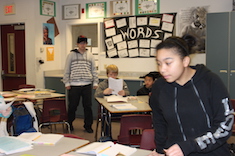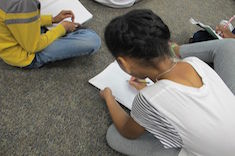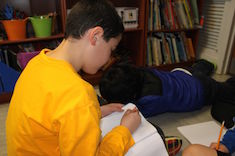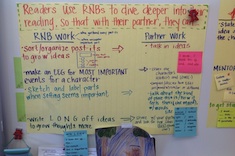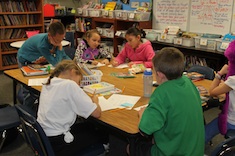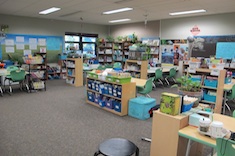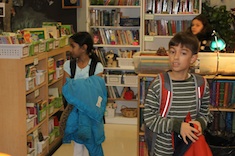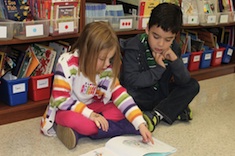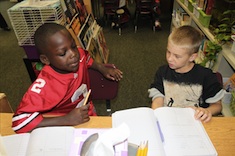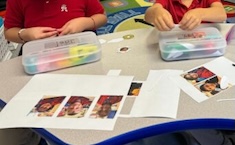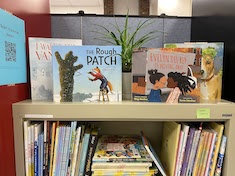Tara Barnett and Kate Mills
Tara Barnett and Kate Mills are teachers in New Jersey. Their favorite years in the classroom have been the ones they co-taught together, when they experienced the powerful effects of professional collaboration for both the teachers and the students in the classroom. They blog together at Tara and Kate.
Latest Content
Protecting Choice and Inquiry with Outdoor Learning Walks
As curriculum shifts in our buildings to feeling more structured, Kate Mills and Tara Barnett reflect on how to protect student choice and opportunities for inquiry. They share a simple and practical way to create opportunity for both choice and inquiry through outdoor learning.
Lessons from a Bird-Watcher: How to Make Space for Students’ Passions
Students are entering our classroom with passions. Tara Barnett and Kate Mills consider how to tap students’ excitement and create space for them to share their interests as part of the learning community.
Latest and Greatest Ways to Show Independent Reading Is Valued
Even as the pressure to add more whole-class reads and articles with focused reading lessons closes in around us with pressure from administrators and school boards, Tara Barnett and Kate Mills are committed to finding ways to get books into students’ hands and show how much they value reading. Here are some of their best tips for keeping the choice in reading—as well as the love of reading—alive.
Purposeful Ways to Incorporate Interactive Writing at the Start of the Year
One of the instructional methods we love the most in primary classrooms is interactive writing. It allows us to target the needs of our learners as individuals and reinforce the phonics rules we’ve been studying whole-class, builds community by co-creating something together, and gives us a chance to use our learning in real, authentic, and purposeful ways. Tara Barnett and Kate Mills offer simple ways you can use interactive writing to co-create your classroom space with your students.
Authentic Audiences for Writing in School
Our student writers deserve to have authentic audiences. Tara Barnett and Kate Mills share two opportunities for authentic peer audiences for finished writing pieces in school. Finding space and time for student writing to be seen and heard by their peers in meaningful ways is essential.
Building Trust in Our Classrooms
Tara Barnett and Kate Mills remind us that more important than the physical layout of the classroom or the assessments we’ll give is the type of community we’ll become. Building a brave and enthusiastic community of learners is the foundation that everything else stands on. They share a community-building experience that can be adapted for any age.
Can AI Help with Assessment?
Tara Barnett and Kate Mills explore using AI to help with grading student writing. In this practical and insightful article, they share a process for using AI as a co-teacher and their reflection on whether it helped them save time (nope) and made their feedback more useful (yep). They share a downloadable student literary essay reflection sheet that you might want to use in your classroom, too.
Harnessing the Power of Words
Tara Barnett and Kate Mills share three quick ways to increase vocabulary exposure in middle school. They also offer a summary of the importance of vocabulary development that inspires the urgency of vocabulary instruction.
Quick and Easy Reading Responses
Tara Barnett and Kate Mills offer three ways for students to write a quick and meaningful response inspired by their independent reading.
Alternatives to a Literary Essay: Two-Voice Perspective Poems
Tara Barnett and Kate Mills offer an alternative to writing a literary essay for middle school students. Providing alternative ways to discuss and demonstrate understanding about reading can be a welcome break from an essay for both students and educators, with valuable learning still taking place.
A Poetic Beginning
Tara Barnett and Kate Mills use poetry to help students discover writing ideas. Inspired by three poems, students share their notebook entries and poems from the first days of a new school year.
Partnering with Families on Reading
Tara Barnett and Kate Mills share ways to make families partners in the pursuit of creating lifelong readers. They share research that makes a case for “just” reading and compelling suggestions for families to support their children’s reading lives.
Creating Learning Progressions with Students
Tara Barnett and Kate Mills outline the steps to involve students in defining how to progress as readers and then set goals. They offer a practical plan for empowering students to take ownership of their learning.
Middle School Reading Routines
Tara Barnett and Kate Mills share ways to establish middle school reading routines. They share two downloads to help support reading routines in all classrooms.
Writing from the Heart
Kate Mills and Tara Barnett pour their hearts into teaching writers, but when Tara loses her family dog, she is reminded that writing is the thing that helps us understand what’s most important.
Teaching Students to Be Teachers
Tara Barnett and Kate Mills share a process for empowering students to be teachers in partnerships and small-group instruction.
Letting Informational Mentors Lead the Way
Tara Barnett and Kate Mills share a practical process for using an informational mentor text to support students as readers and writers. Download a note sheet to support students in noticing text structure.
Infusing Poetic Techniques in Our Writing
Tara Barnett and Kate Mills show how to infuse poetic techniques into writing other genres.
What Should I Teach in a Writing Conference?
Tara Barnett and Kate Mills guide us in determining what to teach in a writing conference. Included is a template to use for conference notes.
Opportunities Offered in Book Shopping
Tara Barnett and Kate Mills remind us of the important opportunities offered during book shopping. Giving yourself permission to slow down and see the opportunities that the routines invite for collaboration and reflection will likely make it feel like you’re maximizing your minutes even more.
Poems to Start the Year
Tara Barnett and Kate Mills share poems to start the year that touch a variety of needs, from building community to connecting with colleagues to hosting parents for back-to-school night.
Honoring Student Identity (Download a Survey)
Tara Barnett and Kate Mills share their authentic process for expanding their beginning-of-the-year student survey to make it more open for all students.
Using The Proudest Blue in the Classroom
Tara Barnett and Kate Mills share three ways using The Proudest Blue by Ibtihaj Muhammad empowers and strengthens readers in all grades.
Interpreting Figurative Language
Tara Barnett and Kate Mills step us through an intentional process to help students understand and interpret figurative language. Using Long Way Down by Jason Reynolds as a mentor text, Tara and Kate give students the skills and confidence to find deep meaning in texts. Download an Interpreting Figurative Language chart to support your students in learning to interpret figurative language.
Bedtime Stories with a Mystery Reader
Tara Barnett and Kate Mills share a wonderful school-wide and home read aloud experience: Bedtime Mystery Reader. They outline all of the details to bring Bedtime Mystery Reader to your school.
Creating Progressions to Meet Learners Where They Are
Tara Barnett and Kate Mills share how to create and use learning progressions to support students in deepening their understanding of theme. Download a copy of a theme progression.
March 25, 2022: Poetry Part 1
This week’s newsletter is the first installment about poetry.
A Perfect Opportunity for Choice: Showing Theme
Tara Barnett outlines ways to offer choices for students to show their understandings of a book’s theme. Download a choice board and rubric.
Honoring Student Choice in a Teacher-Chosen Text
Tara Barnett and Kate Mills offer practical and engaging choices to students when reading a teacher-selected whole-class text. Download the reading choices survey and a sample pacing calendar to offer your students more choice during a whole-class read.
Student-Centered Learning Through Video Lessons
Tara Barnett and Kate Mills consider the power of asynchronous lessons in creating a student-centered learning environment.
Argument Writing Podcast with Tara Barnett and Kate Mills
Tara Barnett and Kate Mills discuss mentor texts for argument writing on the podcast.
Many Uses for Mentor Texts to Teach Argument Writing
Tara Barnett and Kate Mills share the many targeted ways in which they use mentor texts to teach argument writing and move students away from five-paragraph themes.
Actively Recognizing Biases
Tara Barnett and Kate Mills reflect on the ways they actively recognize their own biases and help students recognize their own.
Choice Boards for Writing Workshop
Tara Barnett and Kate Mills give a step-by-step guide for creating choice boards in writing workshop.
Troubleshooting Difficulties When Writing a Big Idea in Memoir
Kate Mills and Tara Barnett pinpoint common difficulties in sixth-grade memoir. They share teaching points and student writing samples before and after revision.
Supporting Students as They Exit Intervention with Series Books
Tara Barnett and Kate Mills write about the power of series books in helping young readers build skills and independence as they exit intervention programs.
Digital Interactive Read Alouds
Tara Barnett and Kate Mills share everything from useful prompts to the best tech tools for moving interactive read alouds to digital platforms during remote instruction.
Preparing for Book Club Discussions
Tara Barnett and Kate Mills find that book clubs succeed when students are given thoughtful tools to prepare for them.
Nurturing Independent Reading Lives in Middle School
Tara Barnett and Kate Mills share their favorite strategies for building a classroom community of readers where everyone has several options for choosing their next book.
Varying Workshop Structures to Meet Student Needs
Tara Barnett and Kate Mills give guidance and support for varying the structures and routines in literacy workshops.
Sparking Ideas for Realistic Fiction
Tara Barnett and Kate Mills explain how they use examples from YA authors of how to mine everyday life for powerful ideas. They then help students move from ideas to blurbs as they start their realistic fiction drafts.
Studying Craft and Punctuation in Sentences from Read Alouds
Tara Barnett and Kate Mills share the power of teaching writer’s craft in bite-sized chunks, through careful study of mentor sentences in read alouds.
Keeping Parent Communication Open in Middle School
Tara Barnett and Kate Mills find that they have to change the way they think about connecting with families once students reach middle school.
Making Paper Packets for Distance Learning
Tara Barnett and Kate Mills write about the challenge of creating meaningful print-based packages of materials for students who don’t have internet access for remote learning.
Remembering the Big Picture in Reading Assessments
Kate Mills notes her own miscues in reading a bedtime story to her young children, and thinks about what that means for analyzing the running records of readers in primary classrooms.
Poetry and Pastiche
Tara Barnett and Kate Mills introduce their middle school students to pastiche, a technique of mimicking the craft of favorite poems and poets.
Teaching Transition Words
Tara Barnett and Kate Mills work with a second-grade team to think through how best to teach transition words during a fairy tale unit, especially to students who are English learners.
It’s All in the Details
Tara Barnett and Kate Mills find their middle school students need some scaffolding to tease out essential details in literature.
Teaching Theme Before the Holidays
Tara Barnett and Kate Mills take advantage of students’ knowledge of Rudolph the Red-Nosed Reindeer to teach the concept of theme before the holiday break.
Building Reading Identities Across the Year
The start of the school year is often all about building reader identities in classrooms. And then October comes, and many of the activities that help students celebrate their reading histories and preferences are forgotten. Tara Barnett and Kate Mills share ways teachers can continue to help students define, refine, and expand their reading identities all year long.
Charting Mentor Texts
Tara Barnett and Kate Mills share many of their favorite anchor charts for helping students connect writer’s craft to mentor texts.
Linking Literacy and Community at the Start of the Year
Tara Barnett and Kate Mills start with the poem “Where I’m From” to build community through literacy at the start of the year.
Growing Talk About Reading
Tara Barnett and Kate Mills find that struggling readers in the early grades benefit from scaffolds and repeated practice in small groups. They share some of their favorite tools, including key ring prompts and anchor charts.
Growing Toward Stories
Tara Barnett and Kate Mills use prompts and aids to help their youngest learners tell stories and find a writing voice.
Getting Started with Strategy Lessons
Tara Barnett and Kate Mills describe how they help teachers move from guided reading to strategy groups in the upper elementary grades.
Reading That Changes Us
Tara Barnett and Kate Mills slow down the “Article of the Week” nonfiction reading activity, making space for more reflection and thoughtful discussion.
Scaffolding Revision with a Mentor Text
Tara Barnett and Kate Mills show how to break down mentor texts into brief excerpts for step-by-step scaffolding of writers in the intermediate grades.
Practical Revision Strategies
If your students are equating revision with proofreading and final cleanups, Tara Barnett and Kate Mills have some practical revision strategies you might want to try.
Linking Evidence to Reading Response in First Grade
Tara Barnett and Kate Mills are discouraged by the random and idiosyncratic responses to reading they are seeing among first graders. They implement a series of lessons to help students move to evidence-based reading responses.
Building Habits with Short-Term Goals
Tara Barnett and Kate Mills explain why short-term writing goals can help students reset expectations for their writing on a daily basis, and how they make these goals an integral part of their writing workshops.
Know and Wonder: Deepening Reflection at the Start of Texts
Tara Barnett and Kate Mills use a know-and-wonder activity to encourage curiosity and independence as their seventh graders begin a new text.
Independent Project Hiccups
Tara Barnett and Kate Mills conclude their series on independent projects with advice on how to handle issues that often crop up as students design and work through writing their projects.
Spreading Love with Compliments
Tara Barnett and Kate Mills close out the year in their eighth-grade classroom with a compliments activity.
Reimagining Reading Logs
Reading logs have fallen out of favor in many classrooms because they often become a rote activity for recording pages read. Tara Barnett and Kate Mills find authenticity with the logs comes when they move from emphasizing recording to goals and reflection.
Managing Independent Projects
Tara Barnett and Kate Mills continue their series on independent projects with nuts and bolts advice on management.
Why We Like Independent Writing Projects
One way to get all students excited about writing workshop is through independent projects. Tara Barnett and Kate Mills explain why they devote many Fridays to independent projects. This is the first installment in a three-part series.
Leveraging Reading Assessment Benchmarks
Benchmark assessments can be incredibly time-consuming for teachers to complete. Tara Barnett and Kate Mills describe how they leverage the time spent by using the assessments in strategy conferences with students.
An Editing Strategy for Run-On Sentences
Is your problem writers whose sentences never seem to end? Tara Barnett and Kate Mills have a strategy for grappling with run-on sentences.
One Text, Many Lessons
Tara Barnett and Kate Mills share how one book can serve as an anchor for lessons on everything from writer’s craft to test-taking skills.
Goals in Small Groups for English Language Learners
Setting small-group goals can be tricky, and the complexity is compounded when you are working with English language learners. Kate Mills explains her goal-setting process with K-3 ELLs, and gives examples of how it works.
Parent Book Clubs
Tara Barnett and Kate Mills lead virtual parent book clubs to foster more home/school connections and build a love of reading outside the school walls.
Preparing Students for Winter Break Reading
Tara Barnett and Kate Mills explain how they avoid a holiday reading slump with students through “break baggies” that include plans developed in the classroom and books selected with peer and teacher input.
Better Writing Response Groups
Tara Barnett and Kate Mills discover giving “compliments and wishes” aren’t enough when it comes to useful feedback for revision in peer groups. They implement a more structured response process for writing groups.
Making Co-Teaching Work
Kate Mills and Tara Barnett often write together about their experiences as co-teachers. They share their best advice for teachers and school administrators on how to make co-teaching partnerships between classroom teachers and special educators work.
Using Mentor Texts Across the Writing Process
Tara Barnett and Kate Mills describe how they use one mentor text, Owl Moon, to teach multiple lessons on craft during a writing unit.
Using Read Alouds to Build Fluency
Tara Barnett and Kate Mills find an ingenious way in the upper elementary grades to help their struggling readers develop fluency through read alouds.
Assessment During On-Demand Writing
Tara Barnett and Kate Mills combine an engagement inventory and an on-demand writing assessment to get a full picture of skills and habits in their classroom community.
Sketching Your Way to a Big Idea
Tara Barnett and Kate Mills work with eighth graders who struggle to articulate big themes in literature. A breakthrough comes when they have the option of sketching their thoughts.
Gradual Release of Responsibility in Small Groups
Tara Barnett and Kate Mills develop a process of pre-assessment, careful planning, and systematic recordkeeping to up the value of their small groups.
Sharing and Celebrating Summer Reading
Tara Barnett and Kate Mills share how they use the first days and weeks of school to celebrate summer reading and build a classroom community.
Using Stories to Launch Writers’ Notebooks
If you're looking for the perfect launch for writers' notebooks this school year, you might want to begin with story. Tara Barnett and Kate Mills explain how.
Practical Ways to Connect Students and Goals
Kate Mills and Tara Barnett provide some practical tips for connecting students and goals.
Creating an On-Demand Writing Checklist
On-demand writing can be a stressful assessment task for students, but it does mimic the type of writing many adults face in their professional lives. Tara Barnett and Kate Mills work with students to create an on-demand writing checklist.
Building Community and Family Connections
Tara Barnett and Kate Mills share suggestions for connecting with parents over the summer and early in the school year, including some fun uses of technology.
Monday Headlines
Tara Barnett and Kate Mills use Monday Headlines to energize students after the weekend, and get a peek into what’s going on at home.
The Ins and Outs of Using a Jot Lot
Tara Barnett and Kate Mills use a jot lot to turn students’ notes on their learning into instructional plans and assessment.
Student-Generated Vocabulary Discussions
Tara Barnett and Kate Mills find the key to middle school students attending to new vocabulary during read-alouds is to have students choose the words.
Setting Weekly Goals
Tara Barnett and Kate Mills share the process of helping students set weekly goals and then reflect on their progress every Friday.
Growing Writing Stamina
Tara Barnett and Kate Mills have a confession to make: in the first weeks of school, many of their fourth-grade students didn’t write much at all in workshops. It was only after tackling the issue of writing stamina head-on that they saw rapid progress.
Supporting Brave Writers
Tara Barnett and Kate Mills use the Sara Bareilles song “Brave” to help their fourth-grade students move from bed-to-bed stories to more emotive writing early in the year.
Bridging the Gap Between Intervention and the Classroom
Kate Mills and Tara Barnett share strategies for building bridges between intervention and classroom instruction.
Charts as Tools, Charts as Teachers
Tara Barnett and Kate Mills give three principles they use to help avoid the “charts as wallpaper” syndrome in their fourth-grade classroom.
Using Mentor Texts to Craft Leads
Tara Barnett and Kate Mills carefully select the first mentor text for crafting leads in their fourth-grade classroom.
Prepping the Meeting Area for Success
Tara Barnett and Kate Mills describe how they set up their meeting area with the right supplies to build community and student independence.
Making the Most of Transitions
Tara Barnett and Kate Mills share strategies for meaningful transitions in their fourth-grade classroom.
Student-Centered Room Setup
Tara Barnett and Kate Mills describe the principles they use to design a student-centered classroom.
Making Plans for Summer Reading
Tara Barnett and Kate Mills begin a few days before the start of break to help students develop summer reading goals and plans.
Purposeful Partners
Tara Barnett and Kate Mills find the young learners in their classroom have mastered the art of turning and talking only with close friends. They provide practical suggestions for expanding the circle of peer response.
Supporting Talk Around Writer’s Craft
Tara Barnett and Kate Mills help young writers move away from seeing editing as “adding more details,” and toward developing more specific language for the revision process.
Setting the Stage for Meaningful Peer Feedback
Tara Barnett and Kate Mills develop a scaffold with an index card to help student partners move from agreeable talk to suggestions for revising writing.
Choosing Books in Verse
Tara Barnett and Kate Mills offer tips and a booklist to position students to read novels in verse.
Setting Middle School Readers Up for Success
Tara Barnett and Kate Mills share ways to set up middle school readers for a successful independent reading life. Download two reading reflections to help students pause and consider where they are and where they want to go as readers.
Managing Independent Projects (SHORTS)
Tara Barnett and Kate Mills continue their series on independent projects with nuts and bolts advice on management.
Using Me Boxes to Promote Identity, Academics, and Play
Tara Barnett and Kate Mills share a powerful (and simple) community activity. Students create their own Me Boxes to use (and update) throughout the school year to promote identity, academics, and play. Me Boxes originated from thinking about developmentally appropriate ways to build in work around identity in the classroom, as taught to us by Gholdy Muhammad in her book Cultivating Genius.
Building Community Access to Texts Through a Lending Library
Tara Barnett and Kate Mills share the way a lending library can provide an additional resource for teachers and community members to quickly get the books they need. They offer practical steps to make the lending library a go-to resource as well as a template to track the monthly book highlights.
Giving Writers What They Need
Tara Barnett and Kate Mills are inspired by their own writing retreat experience to give students exactly what they need to thrive as writers. Take their advice to help writers thrive in your classroom, too.
Browse Content By
Type
Category
- Assessment Tools
- Big Fresh Archives
- Booklists
- Choice Numeracy
- Classroom Design
- Common Core
- Community Building
- Conferring
- Content Literacy
- Digital Literacy
- English Language Learners
- Equity
- Family Relations
- Free Samples
- Guiding Groups
- Leadership
- Literacy Coaches
- Mentor Texts
- Minilessons
- New Teacher Mentors
- Podcasts
- Poetry
- Quote Collections
- Reading Strategies
- Self Care
- Struggling and Striving Learners
- Talking and Listening
- Teacher Study Groups
- Teaching Reading
- Teaching Writing
- Word Study and Vocabulary
Author
- Melissa Quimby
- Nawal Qarooni
- Gwen Blumberg
- Julie Cox
- The Lead Learners
- Hannah Tills
- Josie Stewart
- Ruth Metcalfe
- Mallory Messenger
- Becca Burk
- Jodie Bailey
- Vivian Chen
- Mary Brower
- Tiffany Abbott Fuller
- Stephanie Affinito
- Ruth Ayres
- Leigh Anne Eck
- Heather Fisher
- Shari Frost
- Julie Johnson
- Suzy Kaback
- Gigi McAllister
- Shirl McPhillips
- Melanie Meehan
- Cathy Mere
- Debbie Miller
- Tara Barnett and Kate Mills
- Tammy Mulligan
- Dana Murphy
- Bitsy Parks
- David Pittman
- Brenda Power
- Heather Rader
- Matt Renwick
- Mandy Robek
- Christy Rush-Levine
- Gretchen Schroeder
- Jen Schwanke
- Brian Sepe
- Katherine Sokolowski
- Stella Villalba
- Jennifer Vincent
Grade Level
Choice Literacy Membership
Articles
Get full access to all Choice Literacy article content
Videos
Get full access to all Choice Literacy video content
Courses
Access Choice Literacy course curriculum and training

